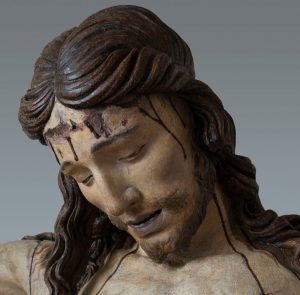Sangallo Crucifix Restored Thanks to ‘Friends of Florence’
 After two and a half years of laborious restoration, a 16th century Crucifix by Sangallo has re-emerged anew. The project was funded by the Friends of Florence, a nonprofit foundation whose mission is to restore works of art in Florence and Tuscany and enrich the public’s appreciation of its rich cultural history.
After two and a half years of laborious restoration, a 16th century Crucifix by Sangallo has re-emerged anew. The project was funded by the Friends of Florence, a nonprofit foundation whose mission is to restore works of art in Florence and Tuscany and enrich the public’s appreciation of its rich cultural history.
Observing the work now, one can see the impressive artistic details of the painted surface which were completely obscured by a dark brown layer painted over the entire crucifix to resemble bronze during the 19th century, since works in bronze were deemed more valuable at that time. In addition, the crucifix suffered from a large-scale woodworm attack which had devastated the sculpture, so the first step the restoration process was to remove the insect infestation and stabilize both the wood and the paint layers.
The Crucifix was made for the church of San Jacopo in Florence. After the church was abolished in 1849, this beautiful wooden sculpture of the Crucifix (about 165 x 160 cm) was passed along to the Accademia delle Arti del Disegno and placed in the complex of the church and Convent della Santissima Annunziata in Florence. Established by Duke Cosimo de’ Medici in 1563, the Accademia is the oldest academy of art in the world still in existence today.
It is under scholarly debate who exactly created the crucifix and when. Many attribute the work to the brothers Giuliano and Antonio Il Vecchio da Sangallo, Florentine sculptor and architect respectively, who experts presume collaborated from roughly 1480 to 1500. Alternatively, some suspect that the work should be accredited to Giuliano’s son, Francesco da Sangallo, because of specific stylistic qualities which are indicative of his work, meaning that the Sangallo Crucifix of would have been sculpted roughly 20 years later.
The project to restore the Crucifix was submitted for the 2014 edition of the Friends of Florence Prize at the Salone del Restauro di Firenze, by conservator Frances Spagnoli, and was selected to be financed by the Friends of Florence. The results of the restoration work are stunning: the removal of the dark coating reveals the color and design nearly perfectly recovered. Minute painted details, such as a faint teardrop on Jesus’s cheek and delicate brush strokes of his hair, are now clearly visible.
The president of Friends of Florence, Simonetta Brandolini d’Adda, is extremely proud of the finished product, and emphasizes that this project has given the public not only a restoration but exciting new historical and aesthetic information about the piece. (reporting by elizabeth wicks)
